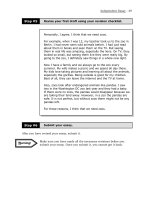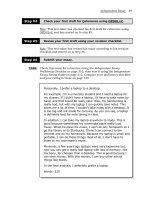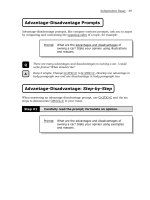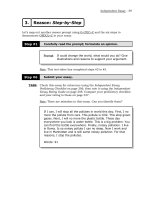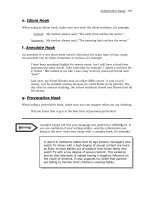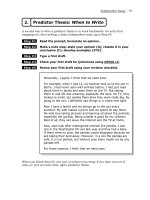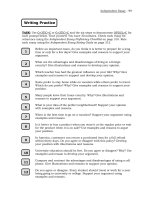Tài liệu Time Management 10 strategies for better time management pptx
Bạn đang xem bản rút gọn của tài liệu. Xem và tải ngay bản đầy đủ của tài liệu tại đây (2.29 MB, 8 trang )
Caption describing picture
or graphic.
INSIDE:
10 strategies for better
Time Management
Sue W. Chapman
Michael Rupured
Know How You
Spend your
Time
Set
Priorities
Use Planning
Tools
Get
Organized
Schedule
Delegate
Stop
Procrastinating
Manage
External Time
Wasters
Avoid Multi-
tasking
Stay Healthy
time management
PAGE 2
The term Time Management
is a misnomer. You cannot
manage time; you manage
the events in your life in
relation to time. You may
often wish for more time
but you only get 24 hours,
1,440 minutes or 86,400
seconds each day. How you
use that time depends on
skills learned through self-
analysis, planning,
evaluation, and self-control.
Much like money, time is
both valuable and limited:
it must be protected, used
wisely, and budgeted.
People who practice good
time management
techniques often find that
they:
• Are more productive,
• Have more energy for
things they need to
accomplish,
• Feel less stressed,
• Are able to do the
things they want,
• Get more things done,
• Relate more positively
to others, and
• Feel better about
themselves (Dodd and
Sundheim, 2005).
Finding a time management
strategy that works best for
you depends on your
personality, ability to self-
motivate and level of self-
discipline. By
incorporating some, or all
of the ten strategies below,
you can more effectively
manage your time.
Analyze
where most
of your time
is devoted—
job, family,
personal,
recreation,
etc.
TIME MANAGEMENT
1. Know How You Spend Your Time
Keeping a time log is a helpful
way to determine how you are
using your time. Start by
recording what you are doing
for 15-minute intervals for a
week or two. Evaluate the
results. Ask if you did
everything that was needed;
determine which tasks require
the most time; determine the
time of day when you are most
productive; and analyze where
most of your time is devoted –
job, family, personal,
recreation, etc. Identifying
your most time-consuming
tasks and determining whether
you are investing your time in
the most important activities
can help you to determine a
course of action. In addition,
having a good sense of the
amount of time required for
routine tasks can help you be
more realistic in planning and
estimating how much time is
available for other activities.
Ten Strategies
For Better
Time Management
PAGE 3
medium and low, number
them in order, or use a
color coding system. Keep
in mind that your goal is
not to mark off the most
items; rather you want to
mark off the highest
priority items (MacKenzie,
1990). Having a prioritized
“to do” list allows you to
say “no” to activities that
may be interesting or
provide a sense of
achievement but do not fit
your basic priorities.
One of the easiest ways to
prioritize is to make a “to
do” list. Whether you need
a daily, weekly or monthly
list depends on your
lifestyle. Just be careful not
to allow the list-making to
get out of control and do
not keep multiple lists at
the same time. Rank the
items on your “to do” list
in order of priority (both
important and urgent). You
may choose to group items
in categories such as high,
that are both urgent and
important must be done,
Covey et.al. suggests that
we spend less time on
activities that are not
important (regardless of
their urgency) in order to
gain time to focus on
activities that are not
urgent but important.
Focusing on these
important activities allows
you to gain greater control
over your time and
possibly reduce the number
of important tasks that do
become urgent.
Managing your time
effectively requires a
distinction between what is
important and what is
urgent (MacKenzie, 1990).
Experts agree that the most
important tasks usually
aren’t the most urgent
tasks. However, we tend to
let the urgent dominate our
lives. Covey, Merrill, and
Merrill (1994) categorize
our activities into four
quadrants in their Time
Management Matrix:
urgent, not urgent,
important and not
important. While activities
2. Set Priorities
regularly scheduled
meetings.
• Investigate additional
software and hardware
that is compatible with
your PDA. You may be
able to enter information
more quickly using a
portable, detachable
keyboard rather than a
stylus, for example. Or,
you may want the ability
to access the Internet for
retrieving files or
checking other
calendars. (Beckwith,
2006)
• Place a notebook the size
of your PDA in your
carrying case for writing
down “to dos” if you
have difficulty recording
them with your PDA’s
task application feature
(Morgenstern, 2004).
Capabilities of PDAs vary by
the model and some users
include WiFi or cellular
technology on their handheld
device. Some suggestions for
using your PDA to its
capacity are:
• Assign a different color
for each calendar item so
that you can distinguish
personal appointments
from business meetings,
for example.
• Use the task application
feature to manage pro-
jects. Most PDAs allow
the user to group tasks
under separate headings,
prioritize tasks and
assign deadlines.
• Use the repeat function
for recurring dates such
as birthdays,
anniversaries, and
Suggestions for Using a Personal Digital
Assistant (PDA) for Time Management
your mind to focus on your
priorities. Auditory learners
may prefer to dictate their
thoughts instead. The key is to
find one planning tool that
works for you and use that tool
consistently. Some reminders
when using a planning tool
are:
• Always record your
information on the tool
itself. Jotting notes
elsewhere that have to be
transferred later is
inefficient.
• Review your planning
tool daily.
• Carry your planning tool
with you.
• Remember to keep a list
of your priorities in your
planning tool and refer to
it often.
• Synchronize electronic
planners with your
computer and recharge the
batteries in your planner
on a regular basis.
• Keep a back-up system.
Time management experts
recommend using a
personal planning tool to
improve your
productivity. Examples of
personal planning tools
include electronic
planners, pocket diaries,
calendars, computer
programs, wall charts,
index cards and
notebooks. Writing down
your tasks, schedules, and
memory joggers can free
3. Use a Planning Tool
PAGE 4
TIME MANAGEMENT
4. Get Organized
Most people find that
disorganization results in poor
time management. Professional
organizers recommend that you
first get rid of the clutter.
A frequently used method is to
set up three boxes (or corners
of a room) labeled “Keep” –
“Give Away” – “Toss.”
Separate the clutter by sorting
items into these boxes.
Immediately discard items in
your “Toss” box. Your “Give
Away” box may include items
you want to sell, delegate, or
discontinue so find a method
to eliminate these items such
as a yard sale, charitable
donation, or gifts to friends or
family members outside your
home.
With the clutter gone, the next
step is to implement a system
that allows you to handle
information (e.g., tasks,
papers, e-mail, etc.) less, only
once, when possible.
1. Throw it away, delete it, or
otherwise get rid of it.
2. Delegate it: give it to
someone else to do, file, or
respond.
3. Act on it yourself. Then
throw it away or file it.
4. File it temporarily until it
needs action or until
additional information is
received. Follow-up: a
“tickler” file can be useful
for holding temporary
information.
5. File it permanently where
you can easily find it later.
(Dodd and Sundheim, 2005).
5. Schedule Your Time Appropriately
Even the busiest people
find time for what they
want to do and feel is
important. Scheduling is
not just recording what you
have to do (e.g., meetings
and appointments), it is
also making a time
commitment to the things
you want to do. Good
scheduling requires that
you know yourself. Using
your time log, you should
have determined those
times during the day when
you are most productive
and alert. Plan your most
challenging tasks for when
you have the most energy.
Block out time for your
high priority activities first
and protect that time from
interruptions.
If you know you will have
waiting time or commuting
time, schedule small tasks
such as writing a letter,
jotting down a shopping
list, reading or listening to
educational audiotapes to
capitalize on the time loss
(Lakein, 1973). Try to limit
scheduled time to about
3/4
th
s of your day, leaving
time for creative activities
such as planning, dreaming,
thinking, and reading.
Block out time for your high
priority activities first and protect
that time from interruptions.
Basically you have 5 options
for handling information:
Implement a system
that allows you to
handle information
only once.
PAGE 5
Delegation begins by identifying tasks that others
can do and selecting the appropriate person(s) to do
them.
6. Delegate: Get Help from Others
Delegation means
assigning responsibility for
a task to someone else,
freeing up some of your
time for tasks that require
your expertise. Delegation
begins by identifying tasks
that others can do and then
selecting the appropriate
person(s) to do them. You
need to select someone
with the appropriate skills,
experience, interest, and
authority needed to
accomplish the task. Be as
specific as possible in
defining the task and your
expectations, but allow the
person some freedom to
personalize the task.
Occasionally check to
determine how well the
person is progressing and
to provide any assistance,
being careful not to take
over the responsibility.
Finally, don’t forget to
reward the person for a job
well done or make
suggestions for
improvements if needed.
(Dodd and Sundheim,
2005)
Another way to get help is
to “buy” time by obtaining
goods or service that save
you a time investment. For
example, paying someone
to mow your lawn or clean
your house, using a
computerized system, or
joining a carpool to
transport your children to
their extracurricular
activities can allow you
free time to devote to other
activities.
You may be putting off tasks for
a variety of reasons. Perhaps the
task seems overwhelming or
unpleasant. Try breaking down
the task into smaller segments
that require less time
commitment and result in
specific, realistic deadlines. If
you’re having trouble getting
started, you may need to
complete a preparatory task
such as collecting materials or
organizing your notes. Also, try
building in a reward system as
you complete each small
segment of the task.
7. Stop Procrastinating
Perhaps the
task seems
overwhelming
or unpleasant.
PAGE 6
TIME MANAGEMENT
• Establish a master calendar for each family member to post their time commitments.
• Make each family member responsible for consulting the master calendar for potential
conflicts.
• Create a central area for posting communications such as appointment reminders,
announcements, and messages.
• Set aside a specific time to view and respond to your mail and e-mail, but don’t let it
accumulate to the point that it becomes overwhelming to sort.
• Turn off instant messaging features on e-mail.
• Handle each item only once, if possible. Practice the options for dealing with clutter listed earlier.
• Sort mail near a garbage can and delete junk e-mail immediately from your electronic mailbox.
• Answer written messages by responding on the margins or bottom of the page.
• Know the purpose of the meeting in advance.
• Arrive on time.
• Start and end the meeting on time.
• Prepare an agenda and stick to it. Use a timed agenda, if necessary.
• Don’t schedule meetings unless they are necessary and have a specific purpose or agenda.
• Establish blocks of time when you are available for visits.
• Tell the visitor politely that you cannot meet with them at this time and schedule the visit
for a more convenient time.
• Set a mutually agreeable time limit for the visit.
• When someone comes to the door, stand up and have your meeting standing.
• Use voice mail and set aside time to return calls.
• Avoid small talk. Stay focused on the reason for the call.
• Stand up while you talk on the phone. You are more likely to keep the conversation brief.
• Take any necessary action immediately following the call.
• Set aside times of the day for receiving calls and let others know when you are available.
• Keep phone numbers readily available near the telephone.
8. Manage External Time Wasters
Your time may be impacted by external factors imposed by other people and
things. You can decrease or eliminate time spent in these activities by
implementing some simple tips listed below.
PAGE 7
Issued in furtherance of Cooperative Extension work, Acts of May 8 and
June 30, 1914. The University of Georgia College of Agricultural and
Environmental Sciences and the U.S. Department of Agriculture
cooperating.
CAES Dean J. Scott Angle, Director
FACS Dean Laura D. Jolly, Associate Director
Publication # HACE-E-71 May, 2008
The University of Georgia and Ft. Valley State University, the U.S.
Department of Agriculture and counties of the state cooperating.
Cooperative Extension, the University of Georgia College of Agricultural
and Environmental Sciences, offers educational programs, assistance and
materials to all people without regard to race, color, national origin, age,
gender or disability.
An Equal Opportunity Employer/Affirmative Action
Organization Committed to a Diverse Work Force
You lose time when
switching from one
task to another,
resulting in a loss
of productivity.
Recent psychological
studies have shown that
multi-tasking does not
actually save time. In
9. Avoid Multi-tasking
fact, the opposite is often
true. You lose time
when switching from one
task to another, resulting
in a loss of productivity
(Rubinsteim, Meyer, and
Evans, 2001). Routine
multi-tasking may lead
to difficulty in
concentrating and
maintaining focus when
needed.
Sources:
Beckwith, S. (2006, July). Unleash Your PDA’s Power. Black Enterprise,
36(12), 66.
Covey, S. R., Merrill, A. R., & Merrill, R. R. (1994). First Things First: To
Live, to Love, to Learn, to Leave a Legacy. New York: Simon & Schuster.
Dodd, P., & Sundheim, D. (2005). The 25 Best Time Management Tools and
Techniques: How to Get More Done Without Driving Yourself Crazy. Ann
Arbor, MI: Peak Performance Press, Inc.
Lakein, A. (1973). How to Get Control of Your Time and Your Life. New
York: New America Library.
MacKenzie, A. (1990). The Time Trap (3
rd
ed.). New York: American
Management Association.
Morgenstern, J. (2004). Time Management from the Inside Out. New York:
Henry Holt and Company.
Rubinsteim, J., Meyer, D. & Evans, J. (2001). Executive control of cognitive
processes in task switching. Journal of Experimental Psychology – Human
Perception and Performance, 27(4), 763-797.
Reviewers:
Sharon Gibson, Joan Mason & Rachel West,
University of Georgia
Bobbie Shaffett, Mississippi State University
Dena Wise, University of Tennessee
Joan Gibson, The Catholic University of America
Designer:
Ashley Bagwell
10. Stay Healthy
The care and attention you
give yourself is an important
investment of time.
Scheduling time to relax, or do
nothing, can help you
rejuvenate both physically and
mentally, enabling you to
accomplish tasks more quickly
and easily. Learn to manage
time according to your
biological clock by scheduling
priority tasks during your peak
time of day, the time your
energy level and concentration
are at their best. Poor time
management can result in
fatigue, moodiness, and more
frequent illness. To reduce
stress, you should reward
yourself for a time
management success. Take
time to recognize that you
have accomplished a major
task or challenge before
moving on to the next activity.
Scheduling time
to relax can
help you
rejuvenate
both physically
and mentally.
Regardless of the time management strategies you use, you should take time to evaluate how they have worked for
you. Ask yourself a few simple questions: Do you have a healthy balance between work and home life? Are you
accomplishing the tasks that are most important in your life? Are you investing enough time in your own personal
wellbeing? If the answer is “no” to any of these questions, then reconsider your time management strategies and
select ones that work better for you. Remember that successful time management today can result in greater
personal happiness, greater accomplishments at home and at work, increased productivity, and a more satisfying
future.
For more information about time management and other related topics, contact
your local county extension office at 1-800-ASKUGA1.


